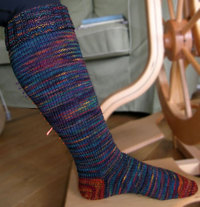
The fit is perfect and well worth the extra effort to get right. Now I have a sock that I can use as a “touchstone” for other socks.
Instead of working cuff to toe I reversed course and started from the toe, adjusting the fit as I knit. This time my tension seemed to be a bit tighter which helps the whole sock to fit much more snugly. Seems a bit odd; I don’t know if this change is due to knitting toe-up or something else. So although the foot and ankle are the same size as the previous sock they do fit more snugly and no adjustments were needed in these sections. There are 48 stitches around the foot with gauge of 6 stitches to an inch and 9 rows to an inch with size 3mm needles.
The increases for the lower section of the leg started at ~3.5 inches after the short-row heel, which is contrary to most instructions I’ve read that say increases should start an inch or so after the heel. Before reaching the widest part of the calf, I knit 10 increases every fifth row (about 1/2 inch apart) and then 4 increases every forth row. I got the idea of changing the rate of increase just before the calf from the book Simple Socks by Priscilla Gibson-Roberts. If you look carefully at the photo (click for closer view) you can see the stitch markers I placed at every decrease at the back of the leg; orange for the first 10 and purple for the last four. This section is about 6.5 inches in length.
Once the circumference of the sock matched the widest part of the calf, I worked straight for about 2.75 inches before working decreases every fourth row until the cuff. This small section of decreases conforms to my shapely upper calf and along with the 2×2 rib will hopefully help the stock stay up better. The cuff is about 3 inches long and is folded over the section of decreases. The total length of the leg minus the cuff is 16 3/4 inches and the foot is 9.5 inches.
This week I’ll finish the mate and start thinking about what to do with my Socks that Rock yarn.

That is really interesting. I am getting ready to start a pair of fair isle socks. Can’t decide whether to make them knee highs or not, but will be following your blog.
LikeLike
Hi Jan,
My next pair using “Socks that Rock” won’t be knee-high but will be a bit longer than any of the socks I’ve made. I’m using these knee-highs to help figure out where to place any increases/decreases.
Right now I’m trying to decide whether I should try to hide the increases within the design or just do them regardless where they fall with the pattern.
LikeLike
Very nice – and boy, you knit that up fast!
LikeLike
Hmm, I have been thinking of knee socks, and have also realized I have to add shaping even to shorter socks, to fit my narrow heel, narrow ankle, and then a major swell to a wide calf. Thanks for the link to the worksheet — that should come in very handy. In the meantime I am trying the Shapely Secrets Socks from Issue #12 of the Heels and Toes Gazette. You’ve inspired me to get back to them.
LikeLike
I normally knit socks top down, but if I ever get around to making knee socks (fingers crossed) I will follow your example and knit them toe up so the trial-and-error of calf shaping goes more smoothly. Thanks for all the detailed info!
LikeLike
Thanks everyone – it’s so encouraging hearing from others.
It’s a personal journey but I hope it might help others as well.
I’m half way through with the second one. I’ll post more details about my leg measurements vs those of the sock when I’m done.
LikeLike